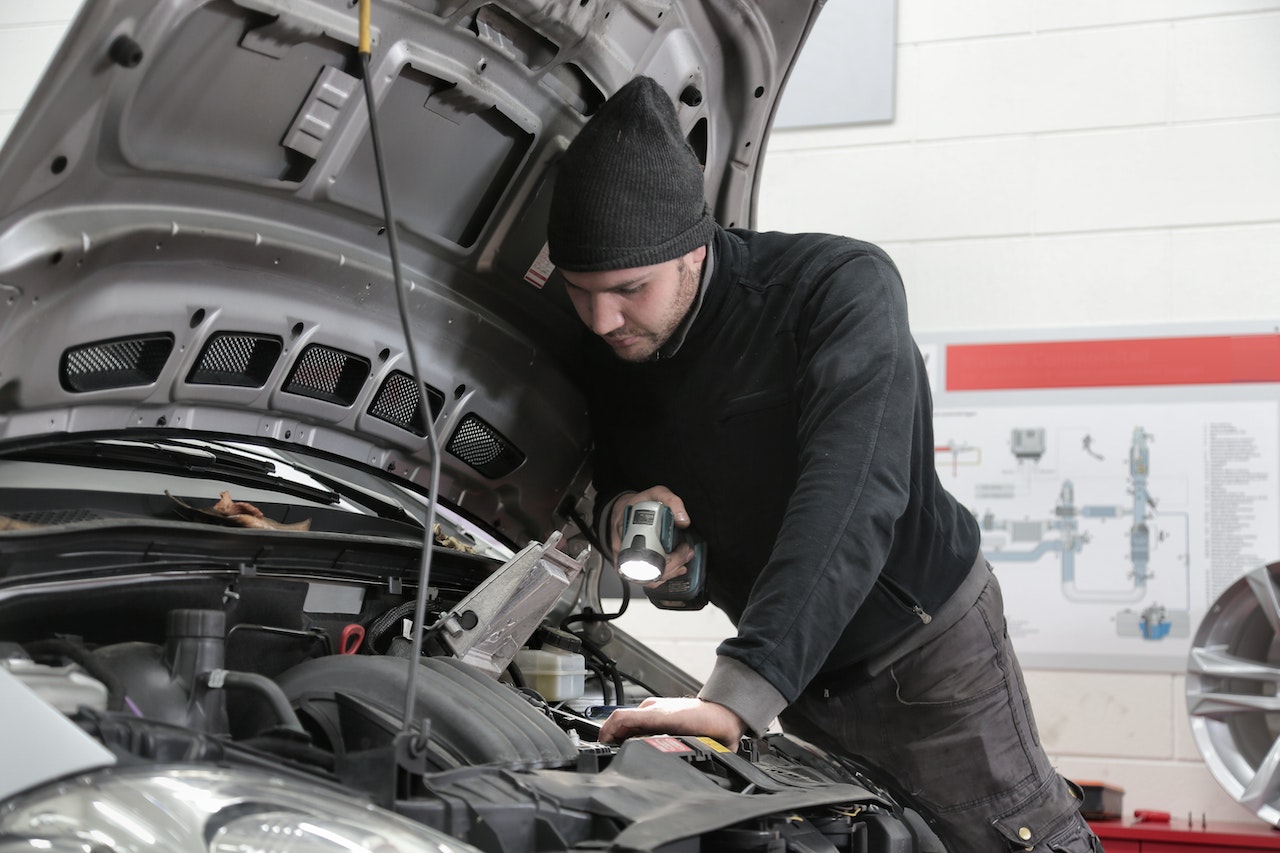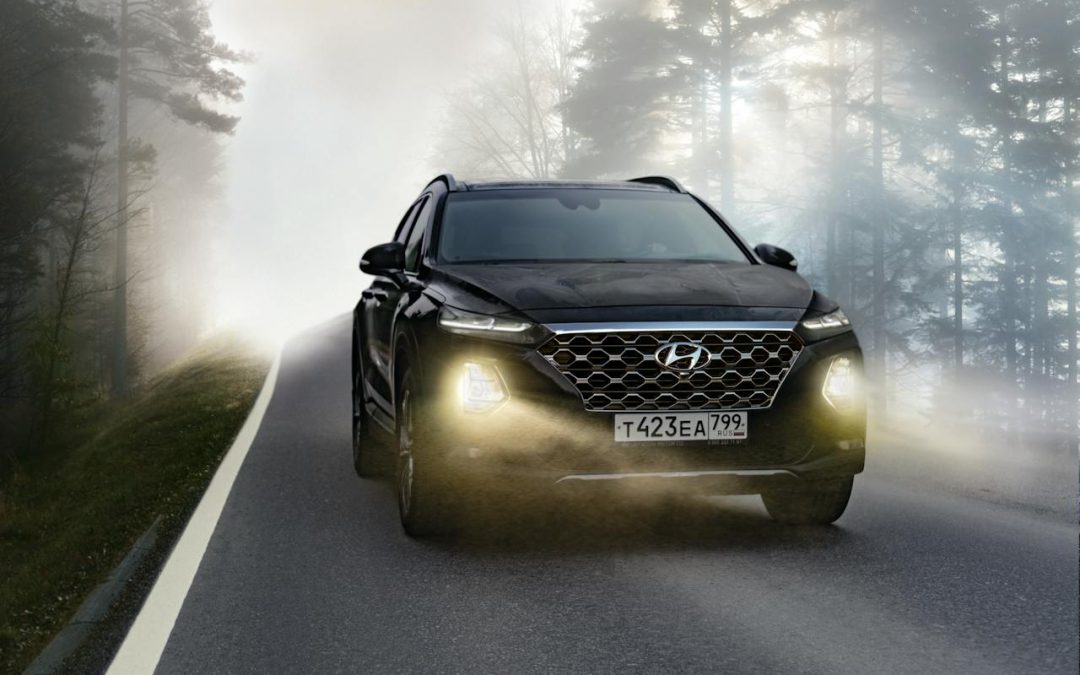Winter car maintenance is important, because cold weather can be especially hard on vehicles. Getting your car ready for the cold weather ahead takes just a few simple inspections and fixes.
Begin with the battery—this is especially important as freezing temperatures can leave batteries drained and underperforming. Check your battery to make sure it’s fully charged and healthy.
Monitor tire pressure regularly, since tire pressure can drop with the temperature. Tire pressure can impact grip on icy roads.
Winter-grade oil will help get your engine up and operating efficiently, so check your antifreeze levels as well. Properly maintain wiper blades so you can see clearly.
By making these preparations, you’ll improve your car’s performance, safety, and reliability when cold weather sets in. Our winter car maintenance survival plan will get you prepared to face whatever winter throws your way.
Basic Winter Car Preparation
Inspect and Replace Tires
Measuring your tire tread depth is an important step to ensure safe driving in winter conditions. Tires need enough grip to get you over snowy, extra icy roads. For severe winter conditions, a tread depth of at least 6/32 inches is suggested.
When their treads are bald, they’ll need to be replaced with winter tires that will provide better traction. Aside from tire tread, you’ll want to make sure your battery is in full working order. Just like with cold weather, battery performance can be cruel, and an old battery could fail unexpectedly.
Additionally, make sure all lights and other electrical accessories are functioning properly. This helps guarantee you’re getting the best visibility and safety, particularly during those long winter evenings.
Test Heating and Defrosting Systems
Your comfort and safety depend on properly working heating and defrosting systems. Check to ensure they’re working to keep you warm and maintain visibility. Antilock brakes and traction control systems are key technologies in the winter, so make sure they are functioning properly.
Look for floor mats that are designed not to slip on the floor. Windshield wipers should be routinely checked, but especially before a snowstorm, stocking your car with winter-grade windshield wipers can make a huge difference.
Additionally, make sure you’re using a winter-grade windshield washer fluid that can help you maintain visibility in the sleet and snow.
Check and Refill Car Fluids
Monitor your vehicle’s fluid levels so they don’t freeze and impact performance. Coolant and windshield washer fluid are increasingly important.
Put together a winter emergency kit with items such as blankets, gloves, and a flashlight. Having snacks and water in the car will help if you get stuck or delayed.
Keep kitty litter or sand in your car, too, and you’ll have an emergency traction aid that can provide grip if you get stuck.
Examine Brake Condition
Brakes should be in peak condition to stop on slippery surfaces. Keep your gas tank at least half full to avoid frozen fuel lines.
When driving, plan routes with weather forecasts in mind to avoid hazards. Slow down and don’t make any sudden moves.
If you must leave your vehicle parked outside, consider a winter car cover to protect your car from snow and ice.
Battery and Electrical System
Protect Your Battery in Cold
Cold weather can be harsh on your car’s battery. So be sure to monitor its state of charge, because when the cold creeps in, batteries can discharge more quickly. Learn why a dead battery causes 30% of all car trouble in the first place.
To avoid being left out in the cold, you might want to carry a portable charger in your automobile. If your battery is over three years old, take this as a sign to get it tested by a pro. Cold weather affects the chemical reactions happening inside the battery.
For one, it increases the amount of power needed to start the car. This is why some drivers choose a battery with a higher cold-cranking amps (CCA) rating for wintertime.
Check Lights and Electrical Components
During winter, with shorter daylight hours, you may find yourself using your car’s lights more frequently. Confirm that all headlights, taillights and turn signals function properly.
Check your electrical system, making sure that dashboard warning lights and your defroster are working, especially important on those frosty winter mornings. Inspecting the condition of your vehicle’s wiring and fuses can help you avoid sudden breakdowns.
A properly operating electrical system increases your safety. That’s critically important when you’re driving in potentially hazardous conditions, such as crossing black ice, a thin and nearly invisible layer of ice on the roadway.
This typically develops in the winter during rain events when the temperature is near 32 degrees F. Keeping your battery and electrical system in great shape lets you enjoy the drive and leave the concerns about your vehicle’s operation behind.
Safety Features and Accessories
Ensure Safety Technologies Function
Safety technologies like anti-lock braking systems and traction control play a huge role in keeping us safe on icy roads. Consistent maintenance makes sure these features function properly in the winter months. So it’s a good idea to get a professional maintenance check to make sure everything is in tip-top order.
That means taking a good look at your tires, the most important factor in safe winter driving. Winter tires have advanced tread designs that grip the road much better, particularly on snow and ice. In rural areas where snow is a bride, tire chains can provide added peace of mind.
Use Appropriate Floor Mats
Floor mats may be an accessory that feels insignificant, but they reduce the chance of slipping while entering or exiting your vehicle. Rubber mats perform better in winter, as they repel water and mud, which is abundant in snowy conditions. They stick to the ground better and help to protect the car’s interior.
Quality mats will prevent moisture from building up, which can freeze and create slipping hazards.
Maintain Windshield Wipers and Fluid
Improved visibility is essential when driving in winter conditions. Wipers should be in good condition to clear snow and sleet. It’s a good idea to put on new blades and stock up on winter windshield fluid.
This fluid won’t freeze and helps in removing ice from the windshield. Don’t forget, the National Safety Council recommends storing a winter emergency kit in your vehicle.
This ought to involve a complete tank of gas, fresh antifreeze, and basics for example blankets and food. Preparation is key when you encounter the unexpected, such as being caught in a snowstorm.
Emergency Preparedness
Assemble a Winter Emergency Kit
A winter emergency car kit is a key to remaining safe in the event of accidents or emergencies such as being stranded in a snowstorm. Add blankets, mittens, socks, and hats to stay warm. A good flashlight and extra batteries are essential too.
Include a first-aid kit stocked with band-aids, adhesive tape, antiseptic wipes, gauze pads, antiseptic cream and medical wrap. Maintaining a supply that lasts a few days is a wise precaution, particularly if you’ll be in hard-to-reach areas.
These essentials will have you prepared for whatever Old Man Winter has in store for you.
Prepare for Potential Stranding
When planning for potential stranding, the best advice is to always keep your gas tank full. All emergency preparedness advice straight from the National Safety Council emphasizes that gas and fuel are often central to emergency preparedness discussions.
This is because they are central to being warm and mobile. Fresh antifreeze is no different. If you become stranded, a fully charged phone and portable charger can be lifesavers.
Being keener connected may make all the difference when you need to call for help in an emergency.
Create a Winter Survival Kit
A winter emergency kit is focused on the immediate, short-term response and survival. Together with your emergency kit, pack non-perishable food such as energy bars and bottled water.
Inspect all of your vehicle’s fluids, from brake to transmission and power steering fluids, to make sure they’re full and clean. This simple check could save on costly breakdown repairs.
Be Ready for Icy Roads
Driving on icy roads still takes a lot of care. Extend your following distance to 8 to 10 seconds. This added space provides more time to stop and avoid a crash.
It’s really all about making your winter commute easier and safer.

Driving and Vehicle Care Tips
Gas Up or Plug In Your Car
Keeping your fuel tank topped off is more than just a precautionary tip. It’s a must during the winter months. Keeping your tank at least half-full prevents moisture from accumulating in your gas lines, which can freeze and lead to blockages.
For EVs, check that your battery is fully charged before you start driving. Cold weather can sap battery efficiency, which can affect your range. If you don’t already have a home charging station, this is the time to invest in a reliable one.
Plan Your Route Carefully
In winter, planning your route becomes even more critical. Monitor weather forecasts and avoid driving on dangerous roads when possible. Know the safest and most reliable routes.
Plan routes prioritizing major roads that will be cleared of snow and ice first. Knowing alternate routes ahead of time can help you avoid losing time and increasing tension should conditions turn bad. Whatever your plans, it’s just smart to be ready for the unexpected.
Be sure to have an emergency kit with items such as a first-aid kit, warm clothing, and more.
Avoid Risky Driving Behaviors
Winter roads require more defensive driving than ever. Since 24% of all weather-related crashes occur on icy pavement, avoiding dangerous driving practices is essential. If you must drive, be sure to maintain a safe following distance.
Make no sudden moves in a way that could lead your vehicle to skid. Make sure your brake system is functioning adequately and be prepared for your brakes to respond differently on slick surfaces. Use winter tires to get better traction in inclement conditions.
Use a Winter Car Cover
A winter car cover will help prevent heavy snow and ice from building up on your vehicle. Bonus: It cuts down on time spent scraping windows and stops frost from accumulating on windshields.
It protects against corrosive substances to keep your car looking great.
Child Safety and Car Seats
Secure Car Seats for Winter
When the temperature drops, a lot of parents put their kids in winter coats. Bulky clothing can impact car seat safety. Bulky coats can prevent the harness from properly fitting against a child’s body.
Instead, provide additional warmth through layers on children, but ensure that kids are still harnessed properly. Once the child is buckled in, you can drape a blanket over the child for additional warmth.
Winter driving can be dangerous. In 2022, there were 498 fatal traffic crashes—over 32,213 injury crashes—on snow or sleet. This is an urgent area of concern, as 21% of children under 13 who died in fatal crashes were unbuckled.
These statistics only serve to reiterate the necessity of wearing a seatbelt correctly and restraining your child in a car seat.
Think back to a time before we all had cell phones. Being stranded by the side of the road was a nuisance. As an EMT, looking for “ICE” (In Case of Emergency) contacts was a common practice.
These days, being prepared with a winter car kit is more important than ever. It should have things such as blankets, a flashlight, and a first-aid kit. Given that I drive all over the state on a weekly basis, I do keep my kit with me at all times.
When our son made a recent trip through an ice storm, it was a great prompt to go through our kits one more time. You don’t ever want to be surprised.
Conclusion
Cold weather can be a challenge for both drivers and their vehicles. The right preparation helps ensure you are prepared and protected. From making sure your battery’s ready to making sure your kid’s car seat is extra secure, every little bit counts. Some simple preparation puts you in command of those cold-weather months and ready to weather winter with confidence. Car issues don’t need to make your day miserable. Don’t forget to keep your emergency kit stocked and your active safety features in working order. Keep your wits about you, and you’ll be sure to take cold weather temperatures in stride like a pro. Looking for more winter car maintenance tips or related content? Contact us or check out our other related content. We’re all in this together, and as always, we’re here to help you cruise through winter without a hitch. We hope you stay warm and safe on the roads this winter!
Are You Looking for Expert Winter Car Maintenance?
If you’re in search of a reliable partner for winter car maintenance with a proven track record, look no further than autoTECH Blackhawk. Why trust us to prepare your vehicle for the colder months? We stand out among independent automotive service providers by building strong, lasting relationships with our customers. This approach allows us to tailor our services to meet your unique winter driving needs—keeping you safe and confident on the road, even in harsh conditions.
Whether your goal is to safeguard your car’s performance, enhance cold-weather handling, or simply ensure reliable starts on icy mornings, our team is here to help. We take pride in making sure your vehicle is ready to take on winter, offering valuable guidance on everything from tire selection to fluid checks and engine tune-ups. Plus, we back our work with an industry-leading 3-year/36,000-mile warranty and only use top-quality parts from trusted manufacturers. Reach out to our friendly team today to schedule a convenient and contactless appointment!


